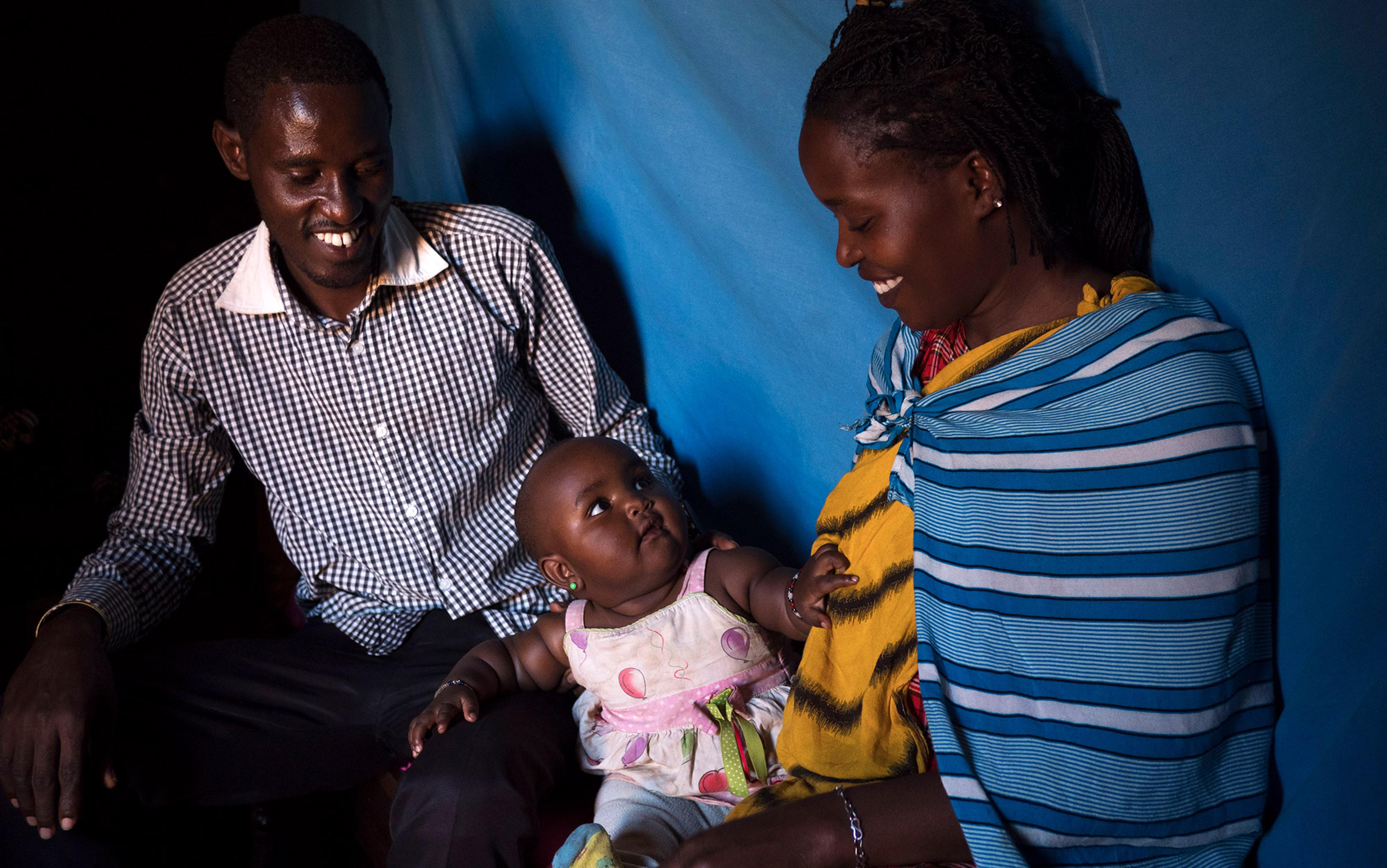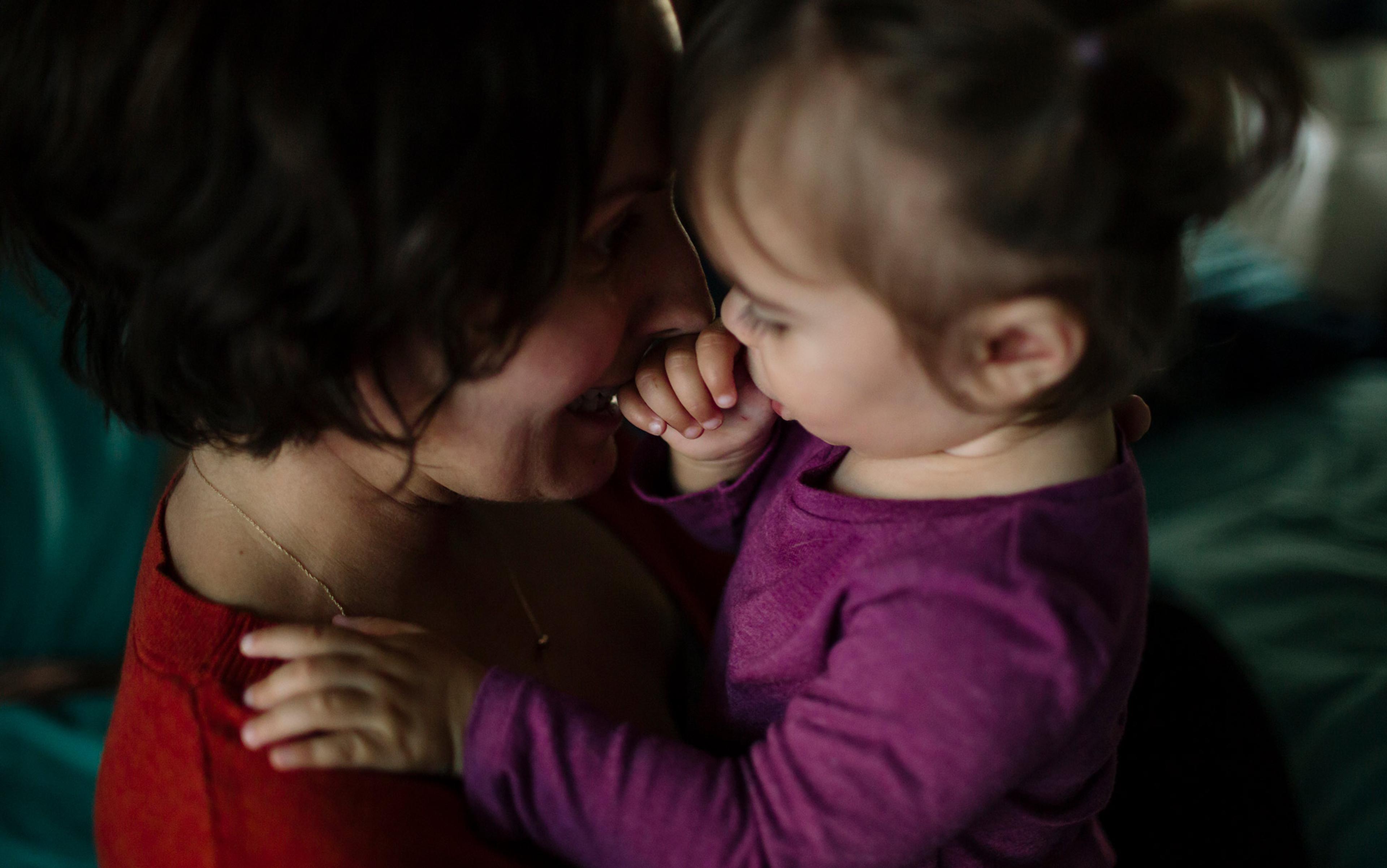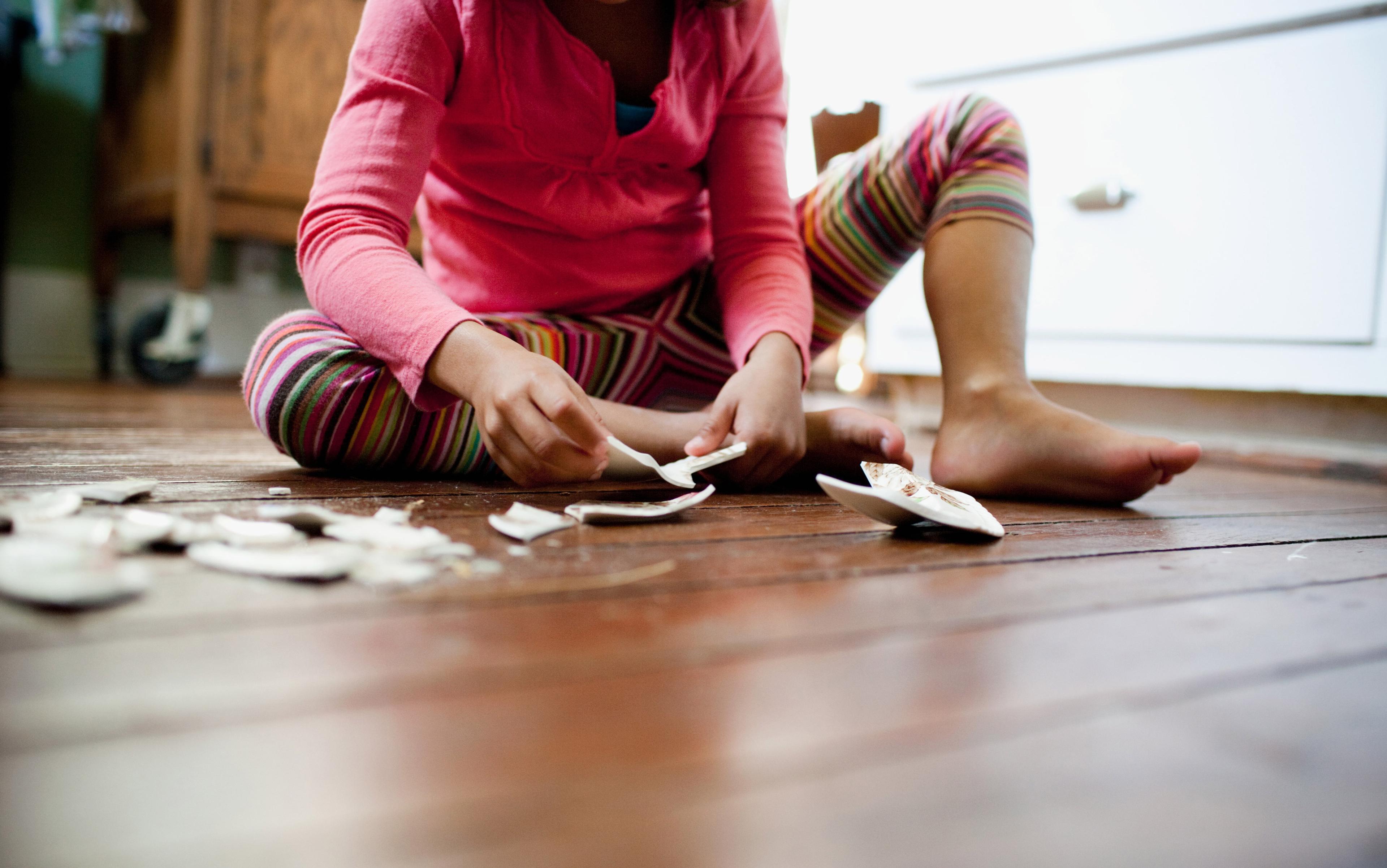In 2008, Georgia (a pseudonym) gave birth to her first child. After struggling with fertility issues, she and her husband were elated to finally become parents. But in the weeks that followed, Georgia’s maternal joy was hijacked by severe anxiety. Throughout the day, her stomach churned and her chest felt tight. At night, she tossed and turned, even though she was bone-tired. Even worse, Georgia’s mind was infiltrated with worrisome and scary thoughts about her baby’s safety.
‘I was convinced I wasn’t feeding my baby enough or soothing him correctly,’ Georgia told me. In her darkest moments, she felt certain an awful tragedy would kill her infant. ‘What if he stopped breathing?’ or ‘What if he choked?’ Her list of worries dredged up deep feelings of maternal insecurity, which caused her to feel unsteady in her new role.
Supportive friends offered Georgia reassurance. ‘I was a nervous wreck until my baby was six months old,’ remarked one friend. ‘You’re a first-time mom, things get easier as the baby gets older,’ said another.
But once the baby dozed through the night, and the sleep deprivation lifted, Georgia’s anxiety lingered. Whenever the baby cried, she swooped in and picked him up, clinging to his squishy body. If she couldn’t stop his tears, she felt irritable and frantic. Always on the lookout for danger, Georgia hovered over her son at the playground, tracking his every move. In her worry-filled mind, if the baby took a tumble, he’d break a bone; if a bee stung him, he’d have an allergic reaction.
‘I was depleted, anxious and overwhelmed. Then, before my son turned one, I got pregnant again,’ she said. Having a second baby made Georgia’s anxiety swell. Terrified to be alone, she set up playdates with other families. To quiet the train of worries, she turned to food for comfort, relying on bread and pasta to temper her emotions. Paralysed by fear, Georgia couldn’t make big decisions. ‘I made choices about my personal and professional life based on what I thought my kids needed.’ At one point, she turned down a stellar job offer, because leaving the kids in someone else’s care seemed impossible.
Finally, Georgia saw her doctor who thought she might be suffering from postpartum depression (PPD), the most common complication of pregnancy that affects up to 15 per cent of new mothers. Characterised by feeling overwhelmed, hopeless and tearful, PPD can be brought on by hormonal shifts, stress and sleep deprivation. In addition, women with a personal or family history of mental illness are at greater risk of becoming depressed during pregnancy and after giving birth. Following her doctor’s advice, Georgia made an appointment with a psychotherapist.
During her first session, Georgia sat back on her therapist’s couch, and spoke about her rocky childhood. Her parents divorced when she was an infant. Substance use, depression and anxiety had plagued each of them. As a result, peaceful family moments were often ruined by angry outbursts and yelling. More often than not, Georgia’s needs weren’t met, and while she knew her parents loved her, she rarely felt safe.
Those parent-child ruptures were not often sutured with an apology, a hug or words of reassurance. If anything, speaking about the divorce was off-limits. ‘My parents couldn’t stand each other, and became upset if I mentioned missing the other parent.’
At the end of her first therapy session, Georgia’s therapist said her anxiety stemmed from what psychotherapists call an ‘attachment wound’ – an emotional scar inflicted by childhood trauma and inconsistent caregiving.
Like many parents, Georgia knew that attachment was vital for a robust mother-baby bond. ‘Pick up the baby when he cries, it fosters healthy attachment,’ childcare experts recommend. However, aside from Georgia’s therapist, no one had mentioned that a parent’s own childhood attachment style could shape their childrearing practices.
Early work on attachment theory can be traced to the physician and psychoanalyst John Bowlby. In 1928, he worked with troubled children at a school in England where he treated a motherless teen and a clingy, anxious child. Those interactions piqued Bowlby’s interest in maternal separation, and its long-term impact on psychological wellbeing. Throughout his career, he worked with orphaned children, and in 1958 he published his first paper on attachment theory. From Bowlby’s perspective, a parent’s role is to provide a ‘secure base’ for the child, and the absence of such nurturing can shortcircuit a child’s ability to trust others, form intimate bonds and, in dire circumstances, can lead to mental illness.
Inspired by Bowlby, the research psychologist Mary Ainsworth continued studying relationship patterns between mothers and their infants. In the 1960s, she developed a study called ‘The Strange Situation’. Ainsworth and her colleagues observed the infant and mother pairs in a laboratory setting, which was the last phase of her maternal research project. The researchers studied how the baby reacted when he was left with a stranger, as well as how he responded when his mother returned.
From her research, Ainsworth came up with three attachment styles: secure, anxious and avoidant. Securely attached infants were distraught by mom’s departure, outgoing with the stranger, and delighted when their mothers returned. Anxiously attached infants, on the other hand, were upset by their mother’s absence, and were not soothed by the stranger. When their caregivers returned, these infants clung to them, but were difficult to comfort. Those with an avoidant attachment style seemed unaffected by their mother’s absence, as well as indifferent to her presence.
Early attachment research suggests the infant-mother bond becomes the blueprint from which future relationship patterns are born. In Becoming Attached (1994), the clinical psychologist Robert Karen writes: ‘the shadow of our parents hangs over us like a fate … determin[ing] whether we can get love right as adults.’ This bond, according to attachment experts, holds clues about how we become who we are. Just as we might inherit our parent’s eye colour, hair colour or quirky sense of humour, we also tend to inherit their attachment style. And each style influences – often unknowingly – how we fall in love, form friendships and parent our kids.
How a parent recalls their early childhood experiences often predicts the nature of their child’s attachment, says the attachment researcher and clinical psychologist Mary Main. In the 1980s, using what they called ‘The Adult Attachment Interview’, Main and her colleagues questioned parents, asking them to recall their earliest childhood memories. The researchers found that the parents’ attachment style corresponded to their own children’s attachment style.
Avoidantly attached individuals can feel burdened when asked to care for others, including their own children
Today, the attachment-based psychotherapist Hilary Jacobs Hendel, author of It’s Not Always Depression (2018), says that those with an anxious attachment style dread being abandoned, work hard to please others, and dismiss their own needs. These parents often feel rejected when their kids seek independence, and can become overly involved in their children’s lives. As adults, the insecurely attached are often less confident, need more reassurance and are more sensitive than their securely attached peers.
In Parenting from the Inside Out (2003), the psychiatrist Daniel Siegel and the parenting expert Mary Hartzell write about how adults who were insecurely attached to their own parents, largely because those parents weren’t always available, often meet parenting with feelings of anxiety and uncertainty. According to the authors, these parents often misread their children’s cues. For instance, when their kids express disappointment, these parents often rush to the rescue, anxious to shut down any sign of distress.
And while the anxiously attached caregiver rushes to the rescue, the avoidantly attached parent keeps a safe distance. Unlike the anxiously attached whose needs were met infrequently, the avoidantly attached child’s care was dropped completely. Such parental absence creates a distorted view of intimacy, writes Jacobs Hendel. Because of this, avoidantly attached adults have difficulty relying on others, because closeness is something to avoid, instead of embrace.
As a result, avoidantly attached individuals can feel burdened when asked to care for others, including their own children. In a study published in 2006 by the journal Personality and Social Psychology Bulletin, researchers surveyed 106 couples about their parenting experiences. The study participants completed prenatal and postnatal questionnaires measuring attachment, anxiety and parental stress. Compared with securely attached parents, those with an avoidant style were more ambivalent about parenthood, more likely to suffer from depression, and were less satisfied in their parental roles, especially when their infants were six months old.
Because their caregivers were emotionally absent, avoidantly attached parents might unknowingly neglect their own children’s distress signals, write Siegel and Hartzell. For instance, their infant’s cries can be interpreted as complaining and, when their children are sick or injured, they might be told to ‘brush it off’. Prizing independence over anything else, avoidantly attached parents might raise their children to be self-reliant, seeing such qualities as necessary for survival.
In 1986, Main identified a fourth attachment style: disorganised. Replicating Ainsworth’s ‘strange situation’ experiment, Main noted that select infants responded to their mother’s return in peculiar ways, exhibiting both fear and avoidance behaviours. For instance, one infant threw her hands in front of her face, while another crept towards his mother and then scurried away.
Frequently, disorganised attachment results from extreme childhood trauma, such as physical and emotional abuse and neglect. Parents with a disorganised attachment style shift between avoidant and anxious behaviours. According to Siegel and Hartzell, such parents can become agitated when their children express joy and excitement, and neglect their cries for help.
Our attachment style can take shape in childhood, but it’s malleable in adulthood. The first step to repairing attachment wounds, according to Siegel and Hartzell, is to understand one’s narrative in a coherent way. ‘Making sense of your life enables you to understand others more fully and gives you the possibility of choosing your behaviours,’ they write.
The psychoanalyst Jill Salberg says that the imprint of trauma lies in how the parent is ‘present and absent, attached at some times and at other times disassociated and not attached, which then becomes transmitted to the child.’ Salberg calls this the ‘texture of traumatic attachment’, and says that analytic psychotherapy provides an opportunity for attunement between patient and analyst, which can be reparative.
Georgia wasn’t my patient, but I’ve treated many women with similar family histories and postpartum struggles. As a treatment for postpartum depression and anxiety, researchers often recommend cognitive behavioural therapy (CBT). A skill-based therapy, CBT helps patients reduce distress by teaching them to flip the script on misguided thinking, or what CBT therapists call ‘thought traps’.
Yet when adverse childhood experiences underpin maternal struggles, attachment-based or psychodynamic therapy can help patients understand their attachment pattern, and its relationship to their suffering. The psychoanalyst Selma Fraiberg in 1975 referred to these patterns as ‘ghosts in the nursery’. Often these ghosts haunt a new mother’s psyche, causing old family traumas and unhealed wounds to spring back to life.
I might say: ‘I wonder if you feel stuck, because as a child, you weren’t allowed to depend on anyone?’
As a psychologist, part of my work is to look for these clues. From the first session, I lean in to my patient’s story, listening for hints that bring their attachment style to light.
For instance, patients with an anxious attachment style can describe their mothers as ‘worrywarts’, and often grew up in families where they tended to their mom’s emotions. Those with an avoidant attachment style might describe parents who pushed them to become independent. Guided by the mistaken belief that ignoring distress makes it vanish, their parents often told them to ‘get over it’ whenever they felt afraid, sad, angry or disappointed. Each mother’s experience varies, but a thread of similarity in these dependency conflicts stands out. Without a consistent caregiver, these women often form misguided notions about what it means to rely on others. For many, it might feel dangerous, shameful or completely off-limits. As a result, the patient develops a ‘false narrative’ that having needs makes one weak, burdensome or incompetent.
Healing attachment wounds starts by creating a ‘coherent’ narrative, which means linking the past with the present. As a psychodynamic psychotherapist, I do this by offering an interpretation. For instance, with a mother who’s feeling guilty about asking for help, I might say: ‘I wonder if you feel stuck, because as a child, you weren’t allowed to depend on anyone?’
Each patient responds differently to an interpretation. Those with an anxious style might move towards the therapist, ready to share more. Avoidantly attached patients might keep a safe distance and back away.
Regardless of the patient’s reaction, I respond with empathy and curiosity. Like an actor preparing for a role, I imagine what it’s like to stand in my patient’s shoes. Stepping inside of their experience can make the unreachable more accessible. Over time, the therapeutic relationship becomes a secure base that the patient trusts, which can help them sort through childhood trauma and disrupted attachment in a safe and supportive way.
Guided by attachment theory and its influence on psychological health, Georgia’s therapist was quick to point out Georgia’s anxious attachment style. Hearing those words, Georgia told me, made perfect sense: ‘It gave me a map to see the world’ – suddenly, ‘everything made sense.’
With the help of her therapist, Georgia strung together her childhood narrative and, by doing so, understood how past experiences had sprung back to life. Alone time with her kids invoked terror, she learned, because she was raised by a single parent and family time was often unstable. When Georgia was the only parent in charge, this family dynamic came back to life.
Georgia also recalled that, at the age of two, she had gone to live with her father. At that time, her mother was mostly absent, and Georgia didn’t see or talk to her much. Her memories of this time were spotty, but recalling and sharing this memory helped Georgia realise why her children’s toddler years had felt terrifying to her. ‘I realised our early childhood losses often re-emerge when our children are the same age,’ she said.
Once she connected the dots, Georgia no longer conflated the past with the present. ‘I could go into those evening experiences knowing, “This is now, and that was then,”’ she explained.
Finally connected to her own needs, Georgia realised that she needed to sleep and exercise, in order to keep her anxiety at bay. She also started taking an antidepressant, and has remained in therapy for more than a decade.
‘At times, my symptoms meet the criteria for an anxiety disorder, but I was also at risk of raising my kids with this anxious attachment style, and those are two different things,’ Georgia said.
Unlike her rocky home life, therapy has been a stable, safe space to unpack and explore her childhood wounds. Like a loving parent, her therapist has been a nonjudgmental, caring and empathic witness who offers Georgia the support she never had.
The pain of the past never fully dissipates; we just learn how to cope with it differently
Certainly, psychotherapy can mend attachment wounds. Attachment-oriented psychotherapists help clients use the body to help heal the mind, teaching them how to read physiological cues for signs of distress, and providing an empathic response to any emotions and memories that arise. But, regardless of the type of therapy one receives, studies show it’s the relationship between therapist and client that matters most.
Of course, parents-to-be can reflect on their early upbringing, even if they don’t speak to a therapist behind closed doors. In Parenting from the Inside Out, Siegel and Hartzell share questions for self-reflection, such as: ‘Do you recall your earliest separations from your parents? What was it like?’ and ‘How did your parents discipline you as a child? What impact did it have on your childhood?’
Answering such questions, according to Siegel and Hartzell, can ‘free your mind from entanglements of the past and liberate you to better understand yourself.’ Noticing what emotions arise can be clues as to whether additional guidance, such as psychotherapy, might be useful.
For instance, recalling a childhood memory that causes tightness in the chest, a knot in the stomach and a desire to escape the emotion can be a sign that something painful needs tending to. On the other hand, not being able to recall much of one’s childhood might also be noteworthy. Those with an avoidant attachment style don’t often remember many of their childhood experiences, often because they were left alone without much engagement, care or conversation from their caregivers.
Healing trauma requires a witness, says Jacobs Hendel. And shifting one’s attachment style from anxious, avoidant or disorganised to secure is a healing process, not an immediate outcome.
Along with self-reflection and psychotherapy, exercises such as mindfulness can also be useful. When we are mindful, write Siegel and Hartzell, ‘we live in the present moment and are aware of our own thoughts and feelings and are open to those of our children.’ Mindful breathing exercises can also help to regulate upsetting emotions, which can calm down an overactive nervous system.
Still, even with those tools, the pain of the past never fully dissipates; we just learn how to cope with it differently. When I interviewed Georgia, she mentioned that she was taking a walk outside. ‘I knew I was going to talk about my childhood, and doing so makes me anxious. Exercise helps,’ she said.
Before beginning psychotherapy, Georgia was flooded with anxiety but, with a new map to guide her, she can now say: ‘As a parent, I want to head in this direction.’ Her past will always be a part of her narrative, but the painful memories no longer haunt her, because she’s identified ways to keep the ghosts at bay.
To read more about psychotherapy and wellbeing, visit Aeon’s sister site, Psyche, a new digital magazine that illuminates the human condition through three prisms: mental health; the perennial question of ‘how to live’; and the artistic and transcendent facets of life.






